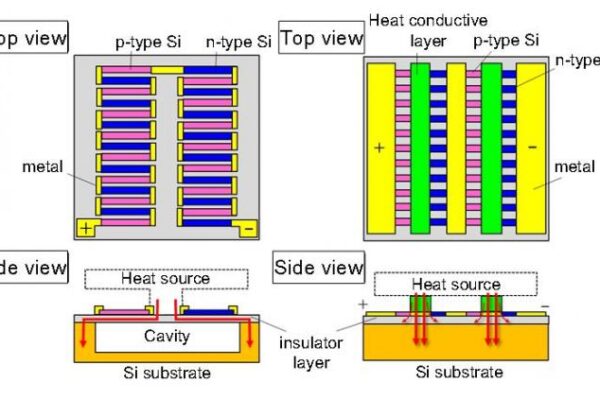
Thermoelectric generator powers IoT nodes from a five degree temperature difference
Silicon nanowires have emerged as a promising thermoelectric material and silicon-based thermoelectric generators conventionally use long silicon nanowires that vary from 10nm to 100nm suspended overa cavity. This architecture avoids the bypassing of the heat current and secures the temperature difference across the silicon nanowires. However, the cavity structure weakens the mechanical strength of the devices and increases the cost of making the devices.
The team from Waseda University, Osaka University, and Shizuoka University developed a design that can be built in a standard CMOS process and has a high power density of 12μW/cm2, enough to drive sensors or power intermittent wireless communication, at a small thermal difference of only 5ºC.
“Because our generator uses the same technology to manufacture semiconductor integrated circuits, its processing cost could be largely cut through mass production,” said Professor Takanobu Watanabe of Waseda University, the lead researcher. “Also, it could open up a pathway to various, autonomously-driven IoT devices us environmental and body heats. For instance, it may be possible to charge your smartwatch during your morning jog someday.”
The generator avoids the cavity structure with shortened silicon nanowires at 0.25 nanometers, as simulations showed that the thermoelectric performance improved by minimizing the size of the wires. This needed argon flouride immersion lithography to generate the nanowires. The new thermoelectric generator demonstrated the same power density as the conventional devices. In addition the thermal resistance was suppressed and the power density multiplied by ten times by thinning the generator’s silicon substrate from the conventional 750nm to 50nm with backside grinding.
Related stories:
- PHASE CHANGE GRAPHENE SYSTEM HARVESTS THERMAL ENERGY FROM DAY/NIGHT CYCLE
- PLASTIC PRINTING SHRINKS THE THERMOELECTRIC GENERATOR
- WASTE HEAT GIVES POWER EFFICIENCY GAINS FOR CARS
 If you enjoyed this article, you will like the following ones: don't miss them by subscribing to :
eeNews on Google News
If you enjoyed this article, you will like the following ones: don't miss them by subscribing to :
eeNews on Google News




